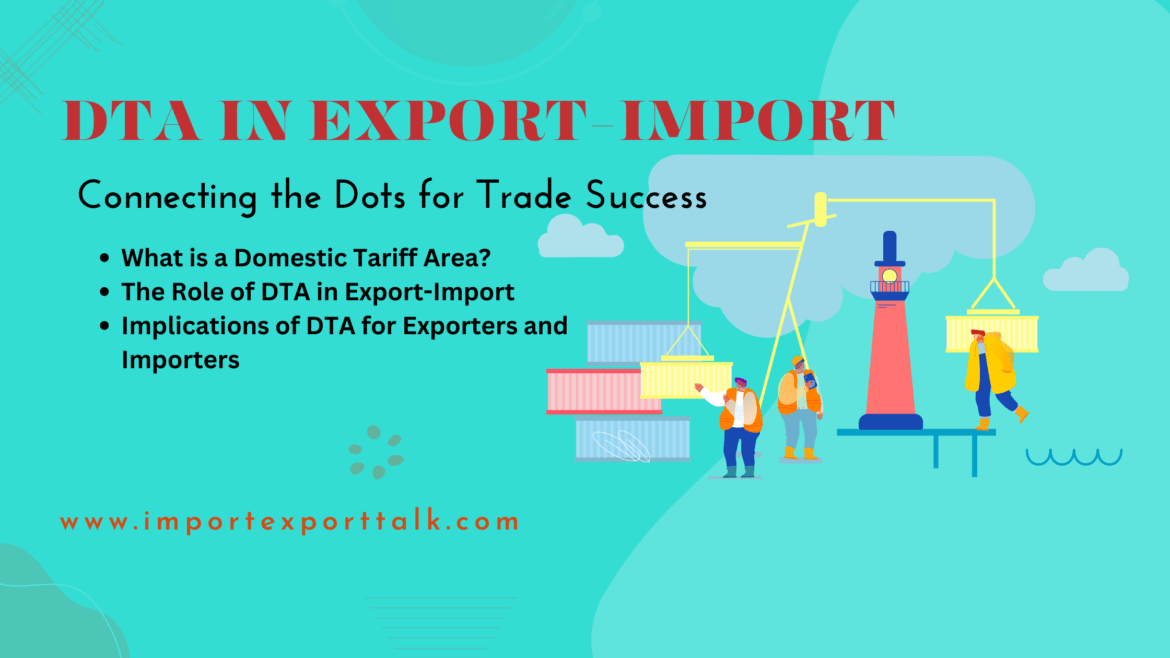DTA in Export-Import, certain terms and concepts play a pivotal role in shaping the movement of goods and the dynamics of trade. One such term is “DTA,” which stands for Domestic Tariff Area. Understanding the significance of DTA in export-import operations is essential for businesses aiming to navigate trade regulations, optimize cost structures, and achieve trade success. The concept of DTA, its implications, and its role in connecting the dots for a successful trade journey.
Exploring DTA in Export-Import: What is a Domestic Tariff Area?
A Domestic Tariff Area, or DTA, refers to the geographical territory within a country’s borders where goods can be imported, produced, stored, and sold without being subjected to customs duties or taxes that typically apply to imported goods. In simpler terms, DTA is the area where a country’s domestic regulations and tariffs are applicable.
The Role of DTA in Export-Import
1. Streamlining Domestic Operations:
DTA streamlines domestic trade operations by allowing goods produced within its boundaries to be freely sold and distributed within the domestic market. This fosters local economic activity and reduces barriers to trade, contributing to economic growth.
2. Export-Import Linkage:
DTA serves as a crucial link between export and import activities. It enables businesses to source raw materials and components from international markets, import them into the DTA for processing or assembly, and then export the finished products to global markets. This linkage facilitates value addition and trade flow.
3. Encouraging Local Manufacturing:
DTA encourages local manufacturing and value addition by providing an environment where businesses can engage in production and assembly activities without incurring customs duties. This support for domestic industries leads to job creation and the growth of various sectors.
4. Enhancing Supply Chain Efficiency:
For businesses engaged in import and export activities, DTA offers the advantage of enhanced supply chain efficiency. Importers can streamline their supply chain by sourcing components or materials from international markets and using DTA facilities for assembly, processing, or customization before exporting the final products. This streamlined process reduces lead times and enables quicker responses to market demands.
Implications of DTA for Exporters and Importers
1. Cost Optimization for Exporters:
Exporters can optimize costs by utilizing DTA in their trade activities. They can source raw materials, components, or semi-finished goods from international markets at competitive prices. These items can then be imported into the DTA for further processing, assembly, or value addition. Since customs duties are deferred until the goods leave the DTA for domestic consumption or export, exporters can lower their operational costs, making their products more competitive in the global market.
2. Regulatory Compliance:
Understanding DTA regulations is crucial for both exporters and importers. Exporters must ensure that their products meet the criteria for DTA processing to qualify for reduced or exempted duties. Adhering to these regulations is essential to unlock the benefits of cost savings and efficient trade operations.
3. Supply Chain Efficiency for Importers:
For importers, DTA presents an opportunity to enhance supply chain efficiency. By strategically sourcing materials from international markets and leveraging DTA facilities for processing or value addition, importers can create a streamlined supply chain. This agility allows businesses to respond more effectively to market demands and changes.
4. Value Addition and Competitiveness:
DTA empowers exporters to engage in value-added activities, such as manufacturing, assembly, or customization, within the DTA. This adds value to the goods and enhances their competitiveness in the global market. By utilizing DTA’s benefits, exporters can offer unique products tailored to specific market demands.
5. Market Access and International Reach:
DTA enables importers to access global markets more efficiently. By sourcing raw materials from international suppliers and utilizing DTA for processing, importers can produce goods that meet international quality standards. This facilitates the export of finished products to various markets, expanding their international reach.
6. Trade Diversification:
Both exporters and importers can use DTA to diversify their trade activities. Exporters can tap into new markets by customizing products to meet specific market preferences. Importers can explore different sourcing strategies to enhance their product range and cater to evolving customer needs.
DTA serves as a critical bridge between export and import activities, offering a platform for cost-effective production, value addition, and streamlined trade operations. Understanding the implications of DTA for exporters and importers is essential for unlocking its potential to drive trade success.
By connecting the dots between export-import activities within a Domestic Tariff Area, businesses can harness the benefits of cost optimization, regulatory compliance, and enhanced supply chain efficiency. DTA is not just a geographical concept; it’s a strategic tool that businesses can leverage to navigate the complexities of international trade and thrive in a globalized economy.


1 comment
DTA in Export-Import